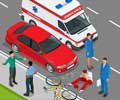Fatalities from road accidents in China nearly doubled in the space of just two decades and are likely to surge further as more and more Chinese acquire a car, a medical study warned on Wednesday.
Fatalities from road accidents in China nearly doubled in the space of just two decades and are likely to surge further as more and more Chinese acquire a car, a medical study warned on Wednesday.
From 1985 to 2005, the death rate from road accidents increased by 95 percent, from 3.9 fatalities per 100,000 people to 7.6 per 100,000, according to the paper, authored by US and Chinese injury researchers."China has to bear a heavy burden from road-traffic injuries, which are the leading cause of death there in people up to the age of 45 years and the first cause of lost working-life years," it said.
The paper, appearing in the journal Injury Prevention, was compiled from two official databases.
The biggest increases in deaths occurred in the developed provinces of the southeast and underdeveloped northern and western provinces.
In terms of the highest death rates per 100 vehicles, though, the roads in sparsely-populated Tibet, Qinghai and Xinjiang were the most dangerous.
Compared with other countries, China's rate of 7.6 deaths per 100,000 people is relatively favourable.
Advertisement
The authors noted that the trend in China was relentlessly upward from 1985 until 2002 but then went slightly downwards until the end of the studied period, in 2005.
Advertisement
Another probable cause was that from 2003, China toughened up traffic policing, introduced standardized warning signs and signals and speed limits.
And the authors cautioned that the official figures may be an underestimate, as administrators may be tempted to under-report casualties to placate their superiors.
If the experience of other countries is a guide, mortalities will rise inexorably as more cars join the road. By one yardstick, the number of deaths could rise by 92 percent from 2000 to 2020.
The paper called for a broad range of measures to stem the carnage, ranging from a police crackdown on high-speed roads to the separation of pedestrians and cyclists and "a broad spectrum of measures" to improve driver behaviour and car safety.
"As in other countries, it is very difficult to change the behaviour of drivers, motorcyclists, pedestrians and other road users in China," said the team, led by Susan Baker of the Johns Hopkins Bloomberg School of Public Health in Baltimore, Maryland.
"More than 50 percent of drivers do not wear seatbelts, motorcycle helmet use is uncommon and bicycle helmet use virtually unknown. Neither has been the focus of educational campaigns or required by law."
Source-AFP
SRM









